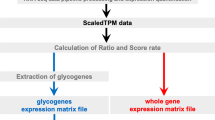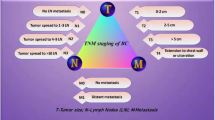Abstract
Glycosylation of cellular proteins has important impact on their stability and functional properties, and glycan structures strongly influence cell adhesion. Many enzymes are involved in glycoconjugate synthesis and degradation, but there is only limited information about their role in breast cancer progression. Therefore, we retrieved RNA expression data of 202 glycosylation genes generated by microarray analysis (Affymetrix HG-U133A) in a cohort of 194 mammary carcinomas with long-term follow-up information. After univariate and multivariate Cox regression analysis, genes with independent prognostic value were identified. These were further analysed by Kaplan–Meier analysis and log-rank tests, and their prognostic value was validated in a second cohort of 200 tumour samples from patients without systemic therapy. In our first cohort, we identified 24 genes with independent prognostic value, coding for sixteen anabolic and eight catabolic enzymes. Functionally, these genes are involved in all important glycosylation pathways, namely O-glycosylation, N-glycosylation, O-fucosylation, synthesis of glycosaminoglycans and glycolipids. Eighteen genes also showed prognostic significance in chemotherapy-treated patients. In the second cohort, six of the 24 relevant genes were of prognostic significance (FUT1, FUCA1, POFUT1, MAN1A1, RPN1 and DPM1), whereas a trend was observed for three additional probesets (GCNT4, ST3GAL6 and UGCG). In a stratified analysis of molecular subtypes combining both cohorts, great differences appeared suggesting a predominant role of N-glycosylation in luminal cancers and O-glycosylation in triple-negative ones. Correlations of gene expression with metastases of various localizations point to a role of glycan structures in organ-specific metastatic spread. Our results indicate that various glycosylation reactions influence progression and metastasis of breast cancer and might thus represent potential therapeutic targets.


Similar content being viewed by others
References
Afratis N, Gialeli C, Nikitovic D, Tsegenidis T, Karousou E, Theocharis AD, Pavao MS, Tzanakakis GN, Karamanos NK (2012) Glycosaminoglycans: key players in cancer cell biology and treatment. FEBS J 279:1177–1197. doi:10.1111/j.1742-4658.2012.08529.x
Arcaro KF, Wang J, Otis CN, Zuckerman BM (2004) Beta-galactosidase and alpha-mannosidase inhibit formation of multicellular nodules in breast cancer cell cultures. Anticancer Res 24:139–144
Auvinen P, Tammi R, Parkkinen J, Tammi M, Agren U, Johansson R, Hirvikoski P, Eskelinen M, Kosma VM (2000) Hyaluronan in peritumoral stroma and malignant cells associates with breast cancer spreading and predicts survival. Am J Pathol 156:529–536. doi:10.1016/S0002-9440(10)64757-8
Brockhausen I (2006) Mucin-type O-glycans in human colon and breast cancer: glycodynamics and functions. EMBO Rep 7:599–604
Brockhausen I (1999) Pathways of O-glycan biosynthesis in cancer cells. Biochim Biophys Acta 1473:67–95
Carvalho AS, Harduin-Lepers A, Magalhaes A, Machado E, Mendes N, Costa LT, Matthiesen R, Almeida R, Costa J, Reis CA (2010) Differential expression of alpha-2,3-sialyltransferases and alpha-1,3/4-fucosyltransferases regulates the levels of sialyl Lewis a and sialyl Lewis x in gastrointestinal carcinoma cells. Int J Biochem Cell Biol 42:80–89. doi:10.1016/j.biocel.2009.09.010
Cazet A, Julien S, Bobowski M, Burchell J, Delannoy P (2010) Tumour-associated carbohydrate antigens in breast cancer. Breast Cancer Res BCR 12:204. doi:10.1186/bcr2577
Contessa JN, Bhojani MS, Freeze HH, Ross BD, Rehemtulla A, Lawrence TS (2010) Molecular imaging of N-linked glycosylation suggests glycan biosynthesis is a novel target for cancer therapy. Clin Cancer Res 16:3205–3214. doi:10.1158/1078-0432.CCR-09-3331
Cooney CA, Jousheghany F, Yao-Borengasser A, Phanavanh B, Gomes T, Kieber-Emmons AM, Siegel ER, Suva LJ, Ferrone S, Kieber-Emmons T, Monzavi-Karbassi B (2011) Chondroitin sulfates play a major role in breast cancer metastasis: a role for CSPG4 and CHST11 gene expression in forming surface P-selectin ligands in aggressive breast cancer cells. Breast Cancer Res BCR 13:R58. doi:10.1186/bcr2895
Gotte M, Yip GW (2006) Heparanase, hyaluronan, and CD44 in cancers: a breast carcinoma perspective. Cancer Res 66:10233–10237. doi:10.1158/0008-5472.CAN-06-1464
Goupille C, Marionneau S, Bureau V, Hallouin F, Meichenin M, Rocher J, Le Pendu J (2000) Alpha1,2fucosyltransferase increases resistance to apoptosis of rat colon carcinoma cells. Glycobiology 10:375–382
Guo Q, Guo B, Wang Y, Wu J, Jiang W, Zhao S, Qiao S, Wu Y (2012) Functional analysis of alpha1,3/4-fucosyltransferase VI in human hepatocellular carcinoma cells. Biochem Biophys Res Commun 417:311–317. doi:10.1016/j.bbrc.2011.11.106
Hatakeyama S, Kyan A, Yamamoto H, Okamoto A, Sugiyama N, Suzuki Y, Yoneyama T, Hashimoto Y, Koie T, Yamada S, Saito H, Arai Y, Fukuda M, Ohyama C (2010) Core 2 N-acetylglucosaminyltransferase-1 expression induces aggressive potential of testicular germ cell tumor. Int J Cancer 127:1052–1059. doi:10.1002/ijc.25117
Hu YY, Zheng MH, Zhang R, Liang YM, Han H (2012) Notch signaling pathway and cancer metastasis. Adv Exp Med Biol 727:186–198. doi:10.1007/978-1-4614-0899-4_14
Ihnen M, Muller V, Wirtz RM, Schroder C, Krenkel S, Witzel I, Lisboa BW, Janicke F, Milde-Langosch K (2008) Predictive impact of activated leukocyte cell adhesion molecule (ALCAM/CD166) in breast cancer. Breast Cancer Res Treat 112(3):419–427
Julien S, Ivetic A, Grigoriadis A, QiZe D, Burford B, Sproviero D, Picco G, Gillett C, Papp SL, Schaffer L, Tutt A, Taylor-Papadimitriou J, Pinder SE, Burchell JM (2011) Selectin ligand sialyl-Lewis x antigen drives metastasis of hormone-dependent breast cancers. Cancer Res 71:7683–7693. doi:10.1158/0008-5472.CAN-11-1139
Kanoh A, Ota M, Narimatsu H, Irimura T (2003) Expression levels of FUT6 gene transfected into human colon carcinoma cells switch two sialyl-Lewis X-related carbohydrate antigens with distinct properties in cell adhesion. Biochem Biophys Res Commun 303:896–901
Karn T, Metzler D, Ruckhaberle E, Hanker L, Gatje R, Solbach C, Ahr A, Schmidt M, Holtrich U, Kaufmann M, Rody A (2010) Data-driven derivation of cutoffs from a pool of 3,030 Affymetrix arrays to stratify distinct clinical types of breast cancer. Breast Cancer Res Treat 120:567–579. doi:10.1007/s10549-009-0416-z
Kikuchi J, Ozaki H, Nonomura C, Shinohara H, Iguchi S, Nojiri H, Hamada H, Kiuchi A, Nakamura M (2005) Transfection of antisense core 2 beta1,6-N-acetylglucosaminyltransferase-1 cDNA suppresses selectin ligand expression and tissue infiltration of B-cell precursor leukemia cells. Leukemia 19:1934–1940. doi:10.1038/sj.leu.2403951
Lau KS, Dennis JW (2008) N-Glycans in cancer progression. Glycobiology 18:750–760. doi:10.1093/glycob/cwn071
Listinsky JJ, Siegal GP, Listinsky CM (2011) The emerging importance of alpha-l-fucose in human breast cancer: a review. Am J Transl Res 3:292–322
Martinez P, Vergoten G, Colomb F, Bobowski M, Steenackers A, Carpentier M, Allain F, Delannoy P, Julien S (2013) Over-sulfated glycosaminoglycans are alternative selectin ligands: insights into molecular interactions and possible role in breast cancer metastasis. Clin Exp Metastasis. doi:10.1007/s10585-013-9592-7
McShane LM, Altman DG, Sauerbrei W, Taube SE, Gion M, Clark GM (2006) REporting recommendations for tumor MARKer prognostic studies (REMARK). Breast Cancer Res Treat 100:229–235
Milde-Langosch K, Karn T, Muller V, Witzel I, Rody A, Schmidt M, Wirtz RM (2013) Validity of the proliferation markers Ki67, TOP2A, and RacGAP1 in molecular subgroups of breast cancer. Breast Cancer Res Treat 137:57–67. doi:10.1007/s10549-012-2296-x
Miles FL, Pruitt FL, van Golen KL, Cooper CR (2008) Stepping out of the flow: capillary extravasation in cancer metastasis. Clin Exp Metastasis 25:305–324
Moremen KW, Tiemeyer M, Nairn AV (2012) Vertebrate protein glycosylation: diversity, synthesis and function. Nat Rev Mol Cell Biol 13:448–462. doi:10.1038/nrm3383
Nairn AV, Aoki K, dela Rosa M, Porterfield M, Lim JM, Kulik M, Pierce JM, Wells L, Dalton S, Tiemeyer M, Moremen KW (2012) Regulation of glycan structures in murine embryonic stem cells: combined transcript profiling of glycan-related genes and glycan structural analysis. J Biol Chem 287:37835–37856. doi:10.1074/jbc.M112.405233
Perez-Garay M, Arteta B, Llop E, Cobler L, Pages L, Ortiz R, Ferri MJ, de Bolos C, Figueras J, de Llorens R, Vidal-Vanaclocha F, Peracaula R (2013) Alpha2,3-Sialyltransferase ST3Gal IV promotes migration and metastasis in pancreatic adenocarcinoma cells and tends to be highly expressed in pancreatic adenocarcinoma tissues. Int J Biochem Cell Biol 45:1748–1757. doi:10.1016/j.biocel.2013.05.015
Potapenko IO, Haakensen VD, Luders T, Helland A, Bukholm I, Sorlie T, Kristensen VN, Lingjaerde OC, Borresen-Dale AL (2010) Glycan gene expression signatures distinguish normal and malignant breast tissue; possible role in diagnosis and progression. EJC Suppl 8:102
Renkonen J, Rabina J, Mattila P, Grenman R, Renkonen R (2001) Core 2 beta1,6-N-acetylglucosaminyltransferases and alpha1,3-fucosyltransferases regulate the synthesis of O-glycans on selectin ligands on oral cavity carcinoma cells. APMIS Acta Pathol Microbiol Immunol Scand 109:500–506
Roberts JD, Klein JL, Palmantier R, Dhume ST, George MD, Olden K (1998) The role of protein glycosylation inhibitors in the prevention of metastasis and therapy of cancer. Cancer Detect Prev 22:455–462
Schmidt M, Bohm D, von Torne C, Steiner E, Puhl A, Pilch H, Lehr HA, Hengstler JG, Kolbl H, Gehrmann M (2008) The humoral immune system has a key prognostic impact in node-negative breast cancer. Cancer Res 68:5405–5413
Shirure VS, Henson KA, Schnaar RL, Nimrichter L, Burdick MM (2011) Gangliosides expressed on breast cancer cells are E-selectin ligands. Biochem Biophys Res Commun 406:423–429. doi:10.1016/j.bbrc.2011.02.061
Stern R (2005) Hyaluronan metabolism: a major paradox in cancer biology. Pathol Biol 53:372–382. doi:10.1016/j.patbio.2004.12.021
Suzuki Y, Sutoh M, Hatakeyama S, Mori K, Yamamoto H, Koie T, Saitoh H, Yamaya K, Funyu T, Habuchi T, Arai Y, Fukuda M, Ohyama C, Tsuboi S (2012) MUC1 carrying core 2 O-glycans functions as a molecular shield against NK cell attack, promoting bladder tumor metastasis. Int J Oncol 40:1831–1838. doi:10.3892/ijo.2012.1411
Taylor-Papadimitriou J, Epenetos AA (1994) Exploiting altered glycosylation patterns in cancer: progress and challenges in diagnosis and therapy. Trends Biotechnol 12:227–233. doi:10.1016/0167-7799(94)90121-X
Udabage L, Brownlee GR, Waltham M, Blick T, Walker EC, Heldin P, Nilsson SK, Thompson EW, Brown TJ (2005) Antisense-mediated suppression of hyaluronan synthase 2 inhibits the tumorigenesis and progression of breast cancer. Cancer Res 65:6139–6150. doi:10.1158/0008-5472.CAN-04-1622
Varki A, Lowe JB (2009) Biological roles of glycans. In: Varki A, Cummings RD, Esko JD, Freeze HH, Stanley P, Bertozzi CR, Hart GW, Etzler ME (eds) Essentials of glycobiology. Cold Spring Harbor, New York
Yuan K, Kucik D, Singh RK, Listinsky CM, Listinsky JJ, Siegal GP (2008) Alterations in human breast cancer adhesion-motility in response to changes in cell surface glycoproteins displaying alpha-l-fucose moieties. Int J Oncol 32:797–807
Yuan K, Listinsky CM, Singh RK, Listinsky JJ, Siegal GP (2008) Cell surface associated alpha-l-fucose moieties modulate human breast cancer neoplastic progression. Pathol Oncol Res POR 14:145–156. doi:10.1007/s12253-008-9036-x
Acknowledgments
We are grateful to Katrin Beck, Sylke Krenkel, Maila Rossberg and Kathrin Eylmann for excellent technical assistance.
Conflict of interest
R.M. Wirtz is an employee of a diagnostic company. The other authors have no competing interests.
Author information
Authors and Affiliations
Corresponding author
Electronic supplementary material
Below is the link to the electronic supplementary material.
Rights and permissions
About this article
Cite this article
Milde-Langosch, K., Karn, T., Schmidt, M. et al. Prognostic relevance of glycosylation-associated genes in breast cancer. Breast Cancer Res Treat 145, 295–305 (2014). https://doi.org/10.1007/s10549-014-2949-z
Received:
Accepted:
Published:
Issue Date:
DOI: https://doi.org/10.1007/s10549-014-2949-z




